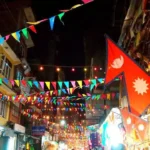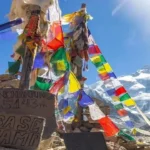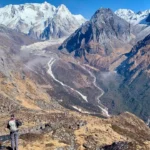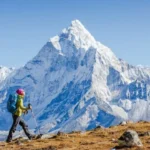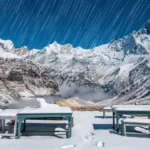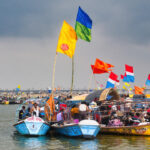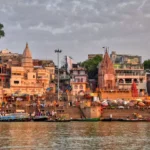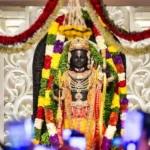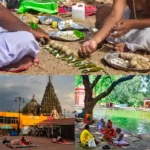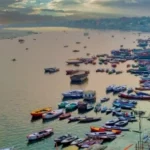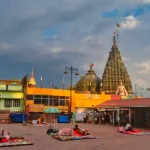What Exactly is Swargadwari?
Swargadwari translates literally from Nepali/Sanskrit as “Swarga” (Heaven) and “Dwar” (Door or Gate), hence the “Gateway to Heaven.” It sits at an elevation of approximately 2,121 meters (6,960 feet) in the southern part of Pyuthan District, Rapti Zone (now Lumbini Province), Nepal. The site isn’t just a single temple but a sprawling complex encompassing temples, an ashram, residential quarters for priests and monks, meditation caves, and, most famously, a large Goshala (cow shelter).
The location itself is breathtaking, offering panoramic views of snow-capped Himalayan peaks like Annapurna, Dhaulagiri, and Manaslu on clear days, contrasted with the rolling green hills and valleys below. But it’s the palpable sense of peace and spiritual energy that truly defines Swargadwari, making it a powerful destination for introspection and devotion.
The Enduring Legend and History of Swargadwari
The story of Swargadwari is intrinsically linked to the life and spiritual accomplishments of its founder, Guru Maharaj Narayan Khatri Chhetri, widely known as Swargadwari Mahaprabhu.
The Early Life and Journey of Swargadwari Mahaprabhu
Born around 1858 AD (1915 BS) in the Rolpa district of Nepal, Narayan Khatri showed spiritual inclinations from a young age. Accounts suggest he left home early in life, wandering as an ascetic, seeking deeper spiritual truths. His journeys took him across Nepal and India, where he engaged in intense meditation and yogic practices. Legends speak of his miraculous powers and profound wisdom acquired through these austerities.
The Divine Calling and Establishment of Swargadwari
According to tradition, Guru Maharaj was divinely guided to the specific hilltop that would become Swargadwari. He arrived there around 1895 AD (1952 BS). He recognised the inherent sanctity of the location and chose it as the centre for his spiritual activities. He began his tenure by performing intense penance and meditation in nearby caves, which can still be visited today.
A pivotal moment in Swargadwari’s history was the initiation of a grand Vedic Yagya (fire sacrifice ritual) by Guru Maharaj in 1895 AD. This was not a temporary event but an ongoing ritual dedicated to world peace and welfare, which, remarkably, is said to continue uninterrupted to this day, fuelled by Ghee (clarified butter) produced from the milk of the ashram’s cows.
The Importance of Cows and the Goshala
Central to Guru Maharaj’s philosophy and the identity of Swargadwari is the reverence for cows. In Hinduism, the cow (Gau Mata) is considered sacred, embodying purity, nourishment, and divinity. Guru Maharaj established a Goshala, starting with a few cows gifted by devotees. He emphasised the service (seva) to cows as a path to spiritual merit.

The Goshala grew significantly under his guidance and remains one of the most prominent features of Swargadwari today, housing hundreds (sometimes reported as thousands) of cows. The milk and ghee from these cows are used exclusively for the temple rituals, particularly the perpetual Yagya, and for feeding the priests, monks, and pilgrims. The Mahaprabhu is believed to have stated that his spiritual power resides within the service to these sacred cows.
Development and Legacy
Swargadwari Mahaprabhu attracted numerous disciples and devotees through his teachings and spiritual aura. He oversaw the construction of temples, ashram buildings, and facilities for pilgrims. He also emphasised Vedic learning and established practices that continue to shape daily life at Swargadwari. He attained Mahasamadhi (conscious departure from the physical body) around 1940 AD (1997 BS), leaving behind a thriving spiritual centre and a legacy of devotion, service, and Vedic tradition. The administration of Swargadwari was later formalised through a Guthi (trust) system to ensure its continued operation and preservation.
Unveiling the Religious and Spiritual Significance
Swargadwari holds immense significance for Hindus for multiple reasons:
The Gateway to Heaven Concept
The name itself signifies the belief that performing pilgrimage here, with sincere devotion, can aid in spiritual liberation (moksha) and potentially lead one towards heavenly realms after death. The arduous journey to reach the hilltop is often seen as a metaphor for the spiritual effort required to attain higher consciousness.
The Power of the Perpetual Yagya
The continuous Vedic fire sacrifice (Akhanda Maha Yagya) is a major source of Swargadwari’s spiritual power. Yagyas are ancient rituals believed to purify the environment, appease deities, and bestow blessings for peace, prosperity, and well-being upon the world. The unwavering continuation of this ritual for over a century is considered a testament to the site’s sanctity and the founder’s spiritual intent. Participating in or witnessing the Yagya is a key part of the pilgrimage.
Reverence for Cows (Go-Seva)
As mentioned, the Goshala is not just an animal shelter; it’s a spiritual powerhouse. Serving the cows (Go-Seva) is considered a highly meritorious act at Swargadwari. Devotees believe that tending to these cows, considered dear to the Mahaprabhu and embodying divinity, earns immense spiritual blessings. The sight of hundreds of peacefully grazing cows on the holy hilltop adds to the serene and pure atmosphere.
Connection to Vedic Traditions
Swargadwari is seen as a bastion of ancient Vedic practices and learning. Guru Maharaj emphasised adherence to Vedic rituals and philosophy. The presence of priests chanting mantras, the performance of fire sacrifices, and the emphasis on purity resonate deeply with traditional Hindu scriptures and practices. Some traditions link the site to legends from the Mahabharata or Puranas, further enhancing its ancient aura, though the primary historical connection is to Guru Maharaj.

Place of Blessings and Wish Fulfilment
Pilgrims flock to Swargadwari with deep faith, seeking blessings for health, prosperity, family well-being, and spiritual growth. Many believe that prayers offered with a pure heart at this potent site are answered. The combination of the sacred geography, the founder’s spiritual energy, the ongoing rituals, and the presence of the divine cows creates a powerful atmosphere conducive to receiving grace.
Exploring the Swargadwari Temple Complex
The Swargadwari complex is a collection of structures spread across the hilltop, designed to support the spiritual life and accommodate pilgrims.
The Main Temple Area
While specific architectural grandeur might not be the defining feature, the main temple area houses the central shrines where prayers and rituals are conducted. Deities worshipped typically include forms of Shiva, Vishnu, and representations related to the Vedic tradition and the Mahaprabhu himself. Pilgrims offer prayers, flowers, fruits, and other traditional items here. The atmosphere is usually calm yet charged with devotional energy.
The Yagyashala
This is the sacred hall where the perpetual Akhanda Maha Yagya takes place. Pilgrims can often witness the priests tending the holy fire, chanting mantras, and making offerings of ghee and grains. The continuous presence of the holy fire is a powerful symbol of Swargadwari’s enduring spiritual purpose.
The Expansive Goshala
A visit to the Goshala is essential. Witnessing the vast herd of cows being cared for is a unique experience. Devotees often donate to the cows’ upkeep or participate in Go-Seva if permitted. The scale of the Goshala underscores the central role of cows in Swargadwari’s philosophy.
The Ashram and Residential Quarters
Swargadwari maintains an ashram providing basic lodging and food (usually simple, vegetarian meals offered as prasad) for pilgrims, priests, monks, and students. These facilities allow devotees to stay overnight and immerse themselves in the spiritual routine of the place.
Meditation Caves
The caves where Swargadwari Mahaprabhu initially meditated are preserved and can be visited. These small, simple caves offer a glimpse into the founder’s ascetic beginnings and provide a quiet space for pilgrims seeking contemplation.
Sanskrit School (Potentially)
Historically, emphasis was placed on Vedic and Sanskrit learning. While the current status might vary, the tradition of learning may still be present in some form, contributing to the site’s role as a centre of traditional knowledge.










